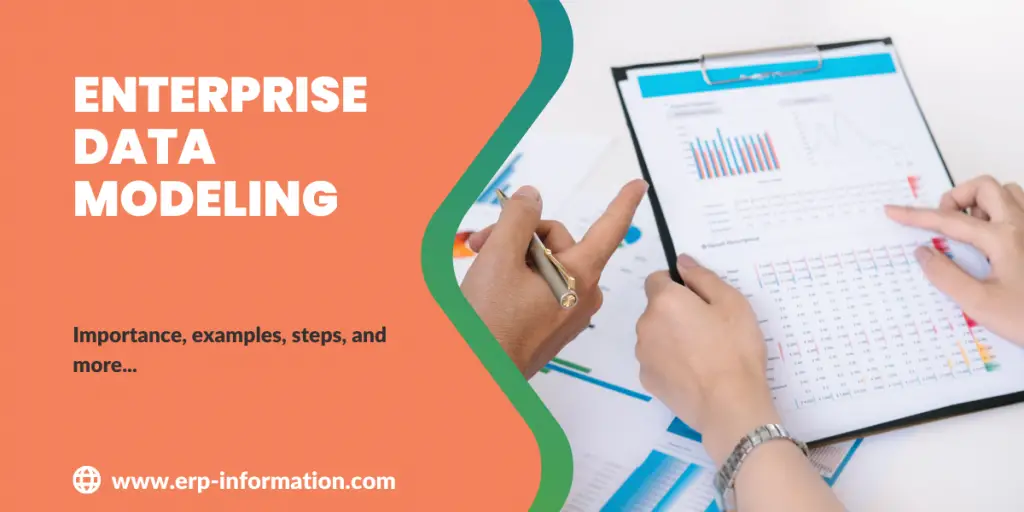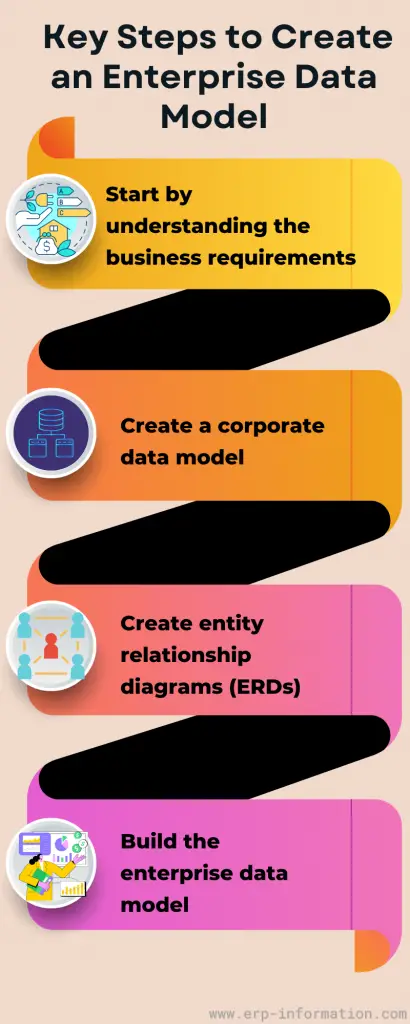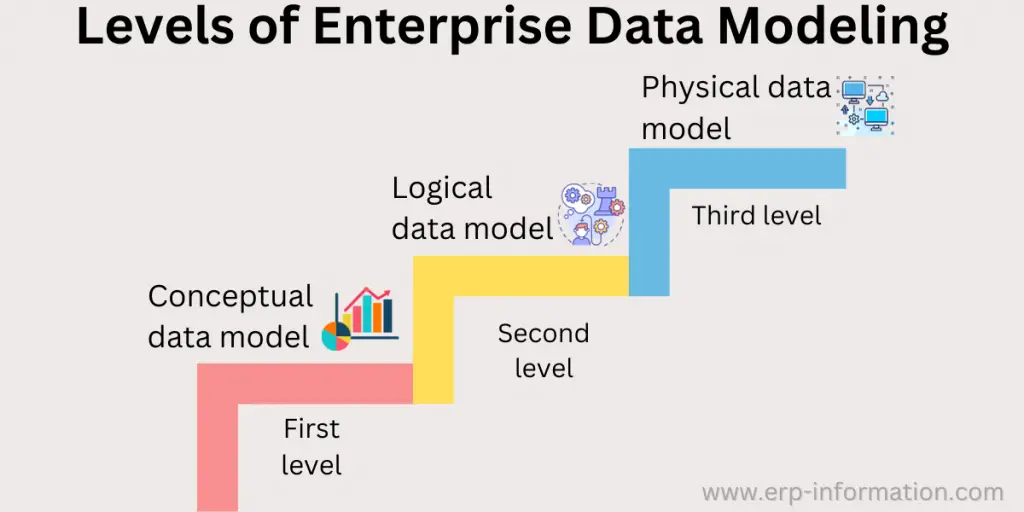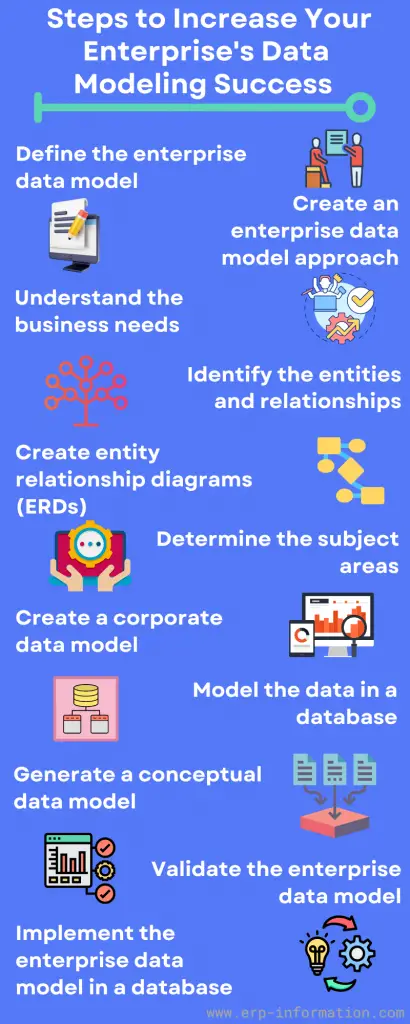In today’s digital world, data is incredibly important. Organizations face the challenge of navigating through this vast amount of data effectively, which is where Enterprise Data Modeling comes in.
It’s not just a method; it’s a blueprint that helps businesses organize and utilize data for various purposes.
Enterprise Data Modeling enables companies to structure and manage data in a smart way. Whether it’s improving supply chains, adhering to regulations, or personalizing customer experiences, this technique is essential for achieving success through data.
In this blog post, we will discuss the need for EDM and the steps involved with examples. We will also look into its levels, and the 11 steps to increase enterprise data modeling success.
Enterprise Data Modeling (EDM)
Enterprise data modeling aims to create a data model allowing the organization to store, manage, and access its data effectively.
Enterprise data modeling is organizing and understanding your company’s data to make better decisions based on your knowledge.
You can unlock previously hidden insights in your records by taking a holistic view of your data and using the latest tools and techniques.
Why Enterprise Data Modeling?
With enterprise data modeling, you can create one used across your enterprise. That saves on development costs; if any changes are needed (which will happen eventually), they only need to be made once rather than multiple times.
Data models save time because enterprise data models are typically more concise and more accessible to understand than project-level data models.
EDM helps you better understand your business. For example, creating an enterprise data model will give you a graphical representation of your company’s data for analysis and decision-making. That can help you improve your business processes and make more informed decisions.
So how do you go about creating an enterprise data model? There are a few key steps.
Key Steps for Enterprise Data Modeling
- Start by understanding the business requirements. What information does the company need to track? What are the goals of the enterprise data modeling initiative?
- Next, create a corporate data model. That is a high-level model that will act as the foundation for the enterprise data model.
- Once the corporate data model is in place, create entity relationship diagrams (ERDs). These diagrams show how the data are related to each other.
- Finally, build the enterprise data model using the ERDs and corporate data model information.
We’ve covered the steps for enterprise data modeling. Let’s look at some examples of enterprise data models.
Enterprise Data Modeling Examples
One example of an enterprise data model is the Starbucks enterprise data model. That was created to track customer transactions at all Starbucks locations worldwide. Enterprise data modeling includes information on customers, orders, products, and more.
Another enterprise data model example is the enterprise information framework (EIF). That is a standardized way of efficiently modeling enterprise data to share among organizations and systems.
IBM created the EIF in 1999 as part of its Smart Enterprise Architecture initiative; since then, other companies like SAP SE and Oracle have created their enterprise information frameworks.
Enterprise Data Modeling Levels
Conceptual data model
The first level of the enterprise data model is the conceptual data model. This level defines the high-level structure of the data and the relationships between the different entities.
It is not specific to any particular database or software. Instead, it is used to understand the overall structure of the data.
Logical data model
The second level is the logical data model. This level defines how the data is stored in a database and how to access it.
Finally, the analytical data model is specific to a database or software used to create a database design.
Physical data model
The third level is the physical data model. This level defines how the data is physically stored on a disk.
The physical data model is specific to a particular hardware and software configuration and is used to create a physical database schema.
How to Increase Your Enterprise Data Modeling Success?
1. Define the enterprise’s data model
It is a high-level conceptual model of the enterprise’s data. It defines the entities (objects) and relationships within the enterprise and the business rules governing those entities and relationships.
2. Create an enterprise data model technique
It will ensure that the enterprise data model is created consistently and accurately. The three primary components are:
- Entity Relationship Diagrams (ERDs) – A graphical representation of the entities and relationships within the enterprise. ERDs can be used to define both the conceptual (high-level) and logical (detail) models.
- Data Dictionary – A dictionary of terms used in the enterprise data model, definitions, and business rules.
- The Unified Modeling Language (UML) – A collection of graphic notations and tools used to design, build, and model software structures. UMLs provide valuable insights into the behaviors or components of data objects, with each diagram type having its own purpose.
3. Understand the business needs
The enterprise data model must be based on understanding the business needs. That includes understanding the business processes and data requirements.
4. Identify the entities and relationships
This can be done using ERDs, data dictionaries, and business rules.
The following are some tips for identifying entities and relationships:
- Use business process diagrams to help identify the activities that occur within the enterprise.
- Use data requirements to help identify the data elements that are needed.
- Use business rules to help define how the entities and relationships behave.
- Do not include too much detail in the enterprise data model. The goal is to capture the high-level concepts, not the low-level details.
5. Create entity relationship diagrams (ERDs)
ERDs are a graphical representation of the enterprise data model. They provide an easy way to visualize how the enterprise entities and relationships come together.
The following are some tips for creating ERDs:
- Start with a high-level view of the enterprise, then drill down into more detail as needed.
- Do not include too much detail in the enterprise data model. The goal is to capture the high-level concepts, not the low-level details.
- Use enterprise architecture tools like Enterprise Architect or Visio to create ERDs.
- Do not include too many entities and relationships in one diagram. Instead, it is better to have multiple diagrams that focus on specific areas of the enterprise.
6. Determine the subject areas
A subject area is a group of related entities, attributes, and relationships that comprise a particular domain within the enterprise. For example, functional departments or business processes typically define subject areas.
The following are some tips for determining the enterprise’s subject areas:
- Use enterprise architecture tools such as Enterprise Architect or Visio to create ERDs.
- Do not include too many entities and relationships in one diagram. Instead, it is better to have multiple diagrams that focus on specific areas of the enterprise.
- Use enterprise data models from other organizations as a reference point when creating yours.
7. Create a corporate data model
It is a high-level enterprise data model that shows the relationships between entities. This type of enterprise data model aims to provide a common understanding of how things relate in an organization so that everyone can work together more effectively.
The following are some tips for creating a corporate enterprise data model:
- Use enterprise architecture tools such as Enterprise Architect or Visio to create your ERDs.
- Do not include too many entities and relationships in one diagram. Instead, it is better to have multiple diagrams that focus on specific areas of the enterprise.
- Use enterprise data models from other organizations as a reference point when creating yours.
- The corporate data model should not contain detailed information about the entities or relationships. Instead, it is just a high-level overview.
8. Model the data in a database.
- This will create the enterprise’s corporate schema. The following are some tips for modeling data in a database:
- Use ERDs to help determine the structure of the database tables. – Use data requirements to help identify the columns needed in each table. – Use business rules to help define the relationships between tables.
- Do not include too much detail in the enterprise data model. The goal is to capture the high-level concepts, not the low-level details.
9. Generate a conceptual data model
A conceptual data model is a high-level view of the enterprise’s data that shows the relationships between entities. It is used to help identify potential problems and gaps in the enterprise data model. The following are some tips for creating a conceptual enterprise data model:
- First, use ERDs to help determine the structure of the database tables.
- Use data requirements to help identify the columns needed in each table. Finally, use business rules to help define the relationships between tables.
- Do not include too much detail in the enterprise data model. The goal is to capture the high-level concepts, not the low-level details.
10. Validate the enterprise data model.
Once it has been created, it needs to be validated. Some tips for validating an enterprise data model are:
- Use enterprise architecture tools such as Enterprise Architect or Visio to create your ERDs.
- Do not include too many entities and relationships in one diagram. Instead, it is better to have multiple diagrams that focus on specific areas of the enterprise.
- Use enterprise data models from other organizations as a reference point when creating yours.
- The corporate data model should not contain detailed information about the entities or relationships. Instead, it is just a high-level overview.
- Model the data in a database to create the enterprise’s corporate schema. That will help to validate the enterprise data model.
- Use data requirements to help identify the columns needed in each table.
- Use business rules to help define the relationships between tables.
- Do not include too much detail in the enterprise data model. The goal is to capture the high-level concepts, not the low-level details.
11. Implement the enterprise data model in a database
Once the enterprise data model has been created and validated, it needs to be implemented in a database. Some tips for implementing an enterprise data model are:
- Use enterprise architecture tools such as Enterprise Architect or Visio to create your ERDs.
- Do not include too many entities and relationships in one diagram. Instead, it is better to have multiple diagrams that focus on specific areas of the enterprise.
- Use enterprise data models from other organizations as a reference point when creating yours.
- The corporate data model should not contain detailed information about the entities or relationships. Instead, it is just a high-level overview.
- Model the data in a database to create the enterprise’s corporate schema. That will help to validate the enterprise data model.
- Use data requirements to help identify the columns needed in each table.
- Use business rules to help define the relationships between tables.
- Do not include too much detail in the enterprise data model. The goal is to capture the high-level concepts, not the low-level details.
- Following are some tips for creating a conceptual enterprise data model:
- Uses ERDs to help determine the structure of the database tables.
- Use data requirements to help identify the columns needed in each table. Finally, use business rules to help define the relationships between tables.
Benefits of Data Modeling
Below is the list of benefits of having data models of all types
- It ensures the accurate representation of data objects in an IT environment
- You can use this information to determine the relationship between primary and tables, foreign keys, and procedures
- After that, you can construct a physical model/database
- These data models help you to communicate with stakeholders
- You can fulfill the model automatically by locating accurate sources
Risks of Data Modeling
Data modeling has some risks associated with it.
- Data creators should have proper knowledge of the characteristics of physically stored data.
- The data model makes the system more complex.
- Even if you make small changes in the data model, you must modify the entire application system.
Enterprise Data Modeling Tools
Following are the top 10 enterprise data model tools
- ER/Studio
- Db Schema
- Erwin
- Luna Modeler
- Archi
- SQL DBM
- Toad Data Modeler
- PgModeler
- DeZign for Databases
FAQs
How can Enterprise Data Modeling improve data integration and interoperability within an organization’s IT ecosystem?
Enterprise Data Modeling establishes a common data language and structure, making it easier to integrate data from diverse sources and systems.
What is the role of EDM in data warehousing projects, and how can it enhance the efficiency of data retrieval and reporting?
Enterprise Data Modeling provides the blueprint for data warehousing, ensuring that data is structured for optimal querying and reporting, which accelerates decision-making.
What is the relationship between data modeling and data architecture, and where does enterprise data modeling fit in?
Data modeling focuses on defining the structure and relationships of data, while data architecture encompasses the infrastructure and technologies to manage data. Enterprise data modeling serves as the foundation for planning and implementing data architecture.
Conclusion
Enterprise data modeling is an essential process for any enterprise. The goal of data modeling is to capture the high-level concepts of the enterprise’s data in a corporate data model.
There are many tips for creating a successful corporate data model, such as using ERDs, data requirements, and business rules.
Enterprise data modeling is also essential to keep the details high, so they can easily translate into a working database schema. Implementing an enterprise data model in a database can help to ensure its accuracy and completeness.



